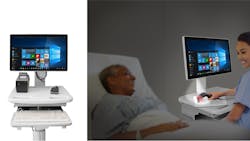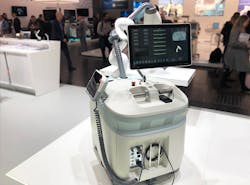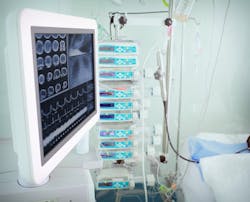Over the past decade, healthcare has been aggressively organizing to use data for better medical care. Healthcare professionals today are routinely using electronic health records (EHRs) to improve their ability to diagnose medical conditions, at the same time reducing and even preventing medical errors for better patient outcomes.
Medical tablets and touchscreen PCs provide the portals into that data. Medical equipment manufacturers collaborate with both hardware and software providers to bring their solutions to the healthcare market, positively impacting patients and providers alike.
In the past, doctors recorded patient information with a pen and clipboard and stored patient files in office filing cabinets. In the mid-2000s, HIPPA and other healthcare regulators made it a requirement to keep electronic medical records (EMRs), also called electronic health records (EHRs). The final deadline for healthcare organizations to switch from paper records to electronic records was in 2014.
For a few years, clinicians continued gathering patient data on paper, and inputting that data into a computer. The transfer of data was sometimes sloppy and inaccurate, and it was a time-consuming process. But then healthcare systems began placing computers at the point of care, to skip the pen and clipboard all together. Now, according to a national survey of doctors cited on the HealthIT.gov website:
- 94% of providers report that their EHR makes records readily available at point of care.
- 88% report that their EHR produces clinical benefits for the practice.
- 75% of providers report that their EHR allows them to deliver better patient care.
Mobile computers and computers installed at the point of care are enabling medical professionals to acquire a wealth of data on their patients and improve their care. The benefits of EHRs can include the ability to manipulate data that can detect problems with the patient’s health and in the hospital or clinic’s operational system.
Qualifying for Medical Computer Applications
Medical touchscreen PCs allow providers to deliver continuity of care, manage risk and prevent liability, but not just any computing device can enter a healthcare environment. Computers used in hospitals and other medical facilities must meet patient needs, safety requirements and the strict demands of the field.
While the requirements can vary drastically depending on the application, there are several standard features for use in a healthcare setting.
Provide the basics. The medical-grade touchscreen PC must have basic functionality: processing speed, storage, inputs and outputs, and the ability to securely connect to a wireless or wired network to allow various medical providers—but not unauthorized users— to access patient records.
Reliability. Healthcare never stops, so in hospitals, medical-grade touchscreen PCs must be able to run 24/7/365 and therefore have the same ruggedness as those units used in the rough world of manufacturing. Reliability is crucial in a demanding healthcare setting, which, of course, is one place where reliability can mean life or death.
Compliance. Does the computer support HIPPA-compliant EHR practices, and is it compatible with the manufacturer’s current operating system and software? There are a lot of compliance measures for medical devices to ensure they are secure and reliable.
Meeting Medical Regulations
Most electronic devices used in medical facilities must carry certifications regarding electrical charge and flow from the device. Some of the common certifications are CE, FCC class A or B, UL60601-1, EN60601-1 and IEC60601-1. 60601-1 certification is the core certification pertaining to the placement of computers near patients or sensitive equipment.
Medical computers also need to have sterile and easy-to-clean bezels. Though computers may seem clean, bacteria, undetectable to the human eye, can easily build up. Standard PCs are not sterile enough for a hospital or other healthcare environment. Medical computers are designed with minimal cracks and crevices to deny hiding places for bacteria to grow. Flush-front designs also make it easy to wipe down the computer between patient visits or surgeries.
Medical computers are built with special antibacterial plastic, or they can have antibacterial coatings that impede the growth of bacteria and germs. The plastic housing is also designed to stand up to harsh, medical-grade cleaners that can degrade and damage the bezel of non-medical-grade computers.
Medical-Grade Computer Features
Fanless cooling. Fans can build up dust and debris, leading to early computer failure. They are also a common point of failure on mobile computers that are bumped or moved around often. Fanless cooling systems don’t push around dust or germs and they allow the computer to run silently.
Fully sealed enclosures. These are easy to clean with sanitizer and don’t allow moisture to invade the inside of the PC.
Antimicrobial touchscreen and enclosure. Antimicrobial plastic or coating prevents the spread of Methicillin-resistant Staphylococcus aureus (MRSA) and other infections by 95%.
Carefully selected I/Os. Standard computers are not designed with medical applications in mind. They can lack important I/Os (inputs and outputs) that are used to connect the computer with common medical devices and peripherals, and they may include irrelevant I/Os that usually go unused in healthcare.
Long life. To meet the demands of medical settings, touchscreens should have a useful life of 100 million touches, and both the internal and external components of the computer need to last (usually a minimum of five years). Installing new computer hardware in a healthcare facility or hospital is a costly undertaking that can take months or even years. So, it is all the important that the computers are built to last.
Mounting design. Units with standard VESA mounts allow easy and reliable attachment to your equipment or system. Some OEM medical machines require a panel-mount or open-frame computer. Medical tablet PCs typically come with a docking station for drop-and-go charging, and sometimes require a customized mounting solution for OEM devices.
Surge protection. Computers that are directly connected to a patient must have surge protection, lest they interfere with the patient or other medical equipment. The best way to protect the patient is to outfit the input/output ports with 4kV isolation, which is accounted for under the IEC60601-1 4th Edition Certification.
Security. It is vital that hospitals protect patient records to satisfy multiple government standards. To ensure a fully secure computing environment, computers used in healthcare should come equipped with a Trusted Platform Module (TPM). The TPM serves as a hardware authentication tool to be used in conjunction with software-based security solutions. TPM is widely considered to be the safest form of computer security and is trusted to keep patient records private.
Improving Computers to Meet Medical Demands
Though medicine has been using PC touchscreens for the past 30 years, you can imagine how far we’ve come, particularly recently. Wireless technology has benefited both computer carts and stationary equipment using touchscreens, particularly with facilities using booster devices and mesh systems.
With the advent of hot-swappable batteries, clinicians now have the option of unplugging the AIO computer from a power source and moving to the next room without restriction. Battery-powered computers now come in 21.5 in. and 23.8 in. and can run up to eight hours without needing to be plugged into power.
As for operating systems, Android isn’t just for smartphones. Thanks to the flexibility offered by this operating system, computers will function successfully with a variety of systems used in a healthcare facility. Plus, Android gives equipment designers a high level of flexibility when it comes to device functionality.
Android provides the flexibility that healthcare, which is always evolving, needs. The operating system makes medical-grade computers even more appealing to developers, who can easily customize applications to accommodate unique I/O devices and create GUIs to manage any medical need.
Android medical-grade computers do not require additional storage capacity and memory requirements that are necessary for Window-based computers. The significant cost savings associated with these differences are driving medical applications towards Android-based computing.
Size is also making a difference. Manufacturers are providing smaller, slimmer, lighter-weight computers that are better able to move around a facility, as cart-mounted computers on wheels (COWs). Mobile computing devices continue to get smaller, too. Medical tablets are easy to carry around and handheld devices can fit into the pocket of a white coat.
As components are shrinking, this compactness (combined with durability) enables these units to go wherever clinicians go. When mounted, these computers take up less room on COWs or in equipment, yet the screens are very readable and available in large-enough sizes for DICOM imaging and medical chart or image reading.
Requirements of Medical Computers for OEM/ODM
Original equipment manufacturer (OEM) projects have special requirements that aren’t typically seen in standard medical computer deployments. This process is best explained with an example.
In 2017, a medical OEM was searching for a computer with 60601-1 certification, a PCIe slot for a graphics card and an anti-bacterial enclosure. The computer would be used with the OEM’s autonomous tissue removal robot that treats lower urinary tract symptoms due to BPH (enlarged prostate). They tested a 21.5-in., medically certified, all-in-one touchscreen computer from Teguar.
After the OEM approved the medical computer in terms of hardware performance, the researchers used the device in clinical trials outside the United States. After a couple of years of successful trials abroad, which included a 181-patient, double-blind, randomized clinical trial, the technology for the treatment of prostate disease gained approval by the FDA for access to the U.S. market.
Throughout the whole process, in this case several years, the OEM and the computer manufacturer must communicate clearly and timely, as to not delay any aspect of the project. Over that time, a consumer-grade computer model will undergo several upgrades, or even be discontinued for a newer model. Medical devices are certified to their exact specs, so the computer cannot simply be switched out for the newer model. This is where a long life cycle is essential. The CPU used in this computer was on Intel’s embedded roadmap, ensuring that it will be available from Intel for more than 10 years.
Today, the manufacturer has deployed about 150 of its autonomous tissue removal robots. They are creating a better healthcare experience for patients by reducing the invasiveness of the surgery and minimizing the commonly experienced complications in current methods for the removal of prostatic tissue. Over the next few years, the device manufacturer expects the device to gain traction in terms of deployment and market use.
This collaboration has been successful because the computer used in this project provided a forward-looking solution. The computer met the project needs at the time and in the future, in terms of spec requirements, but also would meet the stringent FDA requirements.
Jacob Valdez is a sales manager at Teguar Computers, a Charlotte, N.C. provider of industrial and medical PCs.



